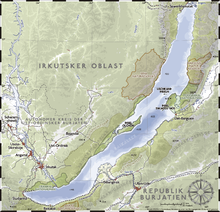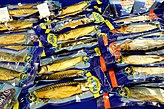Omul
| Omul | |
|---|---|

| |

| |
| Omul (freshly caught above, smoked below) | |
| Scientific classification | |
| Domain: | Eukaryota |
| Kingdom: | Animalia |
| Phylum: | Chordata |
| Class: | Actinopterygii |
| Order: | Salmoniformes |
| Family: | Salmonidae |
| Genus: | Coregonus |
| Species: | C. migratorius
|
| Binomial name | |
| Coregonus migratorius (Georgi, 1775)
| |

| |
| Lake Baikal, the only home of the omul | |
The omul, Coregonus migratorius, also known as Baikal omul (Russian: байкальский омуль), is a whitefish species of the salmon family endemic to Lake Baikal in Siberia, Russia. It is considered a delicacy and is the object of one of the largest commercial fisheries on Lake Baikal. In 2004, it was listed by an unknown group in Russia as an endangered species.
Taxonomy
The omul has traditionally been regarded as a subspecies of the Arctic cisco Coregonus autumnalis. However, recent genetic studies have shown it actually belongs to the circumpolar Coregonus lavaretus-clupeaformis complex of lake whitefishes, which also has other members in Lake Baikal,[1] and it is now considered its own species within Coregonus.[2] The four or five traditionally accepted subpopulations of omul within Lake Baikal are: North Baikal (северобайкальский), Selenga (селенгинский), Chivyrkui (чивыркуйский) and Posolsk (посольский). These vary in size, feeding behaviors and preferred spawning habitats. The extent of their reproductive isolation is debated.
Description
The omul is a slender,
Behavior
The omul feeds primarily on
Consumption and fishery
Omul is one of the primary food resources for people living in the Baikal region. It is considered a delicacy throughout Russia, and export to the west is of some economic importance. Smoked omul is widely sold around the lake and is one of the highlights for many travelers on the
Due to its high demand, the omul is the object of one of the most important commercial fisheries in Lake Baikal. The highest recorded annual landed catches occurred in 1940s and amounted to 60-80 thousand tonnes.[3] A subsequent crash in the population led to a closing of the fishery in 1969, followed by a reopening with strict quotas in 1974 after some recovery of the stocks.[4] Currently, the omul fishery accounts for roughly two-thirds of the total Lake Baikal fishery.[5] Fluctuations in the population and intensive fishing make sustaining the fishery one of the highest priorities for local fisheries managers.
Conservation
The omul's main food source is an
Gallery
-
Freshly caught Baikal omul
-
Baikal omul
-
Baikal cold-smoked omul on the counter of the store
-
Omul on a cutting board
See also
References
- ^ a b Sukhanova, L.V.; et al. (2004). "Grouping of Baikal Omul Coregonus autumnalis migratorius Georgi within the C. lavaretus complex confirmed by using a nuclear DNA marker" (PDF). Ann. Zool. Fenn. 41: 41–49.
- ^ a b Froese, Rainer; Pauly, Daniel (eds.) (2008). "Coregonus migratorius" in FishBase. 1 2008 version.
- ^ Research-Educational Center "Baikal": FAQ
- ^ Galazin, G.I. (1978) Рыбные ресурсы Байкала и их использование (Fish resources of Baikal and their exploitation). Problemy Baikala, Siberian Division of the Russian Academy of Sciences, Novosibirsk, v. 16 (36). (in Russian) [1]
- ^ Ye.I. Buyanova (2002) Экология рыбного хозяйства бассейна озера Байкал (Ecology of commercial fisheries on Lake Baikal), MSU, Moscow, 2002. (in Russian) [2] Archived 2007-12-23 at the Wayback Machine
- ^ Lonely Planet Trans-Siberian Railway
External links
 Media related to Coregonus migratorius at Wikimedia Commons
Media related to Coregonus migratorius at Wikimedia Commons




